Limerick 1912-1922
The Limerick city branch of Cumann na mBan was founded on 5 June 1914, with over 100 women joining. The Daly sisters, led by Madge, were the local leaders. In May 1915, the Irish Volunteer newspaper described their organisation as one of the most ‘flourishing’ in the country. It had a direct and controlling influence on some of the major developments in politics in Limerick city between its foundation and 1922. In county Limerick, members of Cumann na mBan were involved in gun-running and nursing, and also in military confrontations.
For more information on the locations involved please see below.
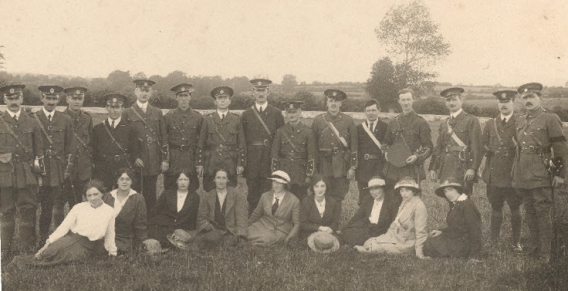
Pictured above: Limerick City Volunteers and Cumann na mBan, c. 1915. Reproduced from the Daly Papers, Glucksman Library, University of Limerick.
Front row, left to right: Mrs Bermingham, Mary Clancy, Miss Downey, Mrs MacCormack, Eileen Crowe, Eileen O’Donoghue, Siún O’Farrell, Madge Daly, Carrie Daly.
Back row, left to right: Ned O’Toole, James O’Driscoll, Alphonsus O’Halloran, John Grant, James Ledden, Liam Forde, George Clancy, David Hennessy, Jimmy Kirby, James MacInerney, Stephen Dineen, Michael Colivet, James Dalton, Patrick Walsh, Robert Monteith.
The Limerick branch of Cumann na mBan was founded on 5 June 1914 in the Gaelic League (Conradh na Gaeilge) rooms, 18 Thomas Street, with over 100 women joining.
Madge Daly became President, Máire O’Donovan (described in the press as Mrs. Dermot O’Donovan) became Vice-president, and Mary Killeen became Secretary. Other members were Laura Daly, Kate O’Callaghan, Mrs Bermingham, Miss Downey, Eileen O’Donoghue, Siún O’Farrell, Mrs Eileen Crowe, Mrs McCormack and Eilís Ní Mhurchú. Kate O’Callaghan, Eilís Ní Mhurchú and Máire O’Donovan were sisters and university graduates, and were lecturers in Mary Immaculate College of Education.
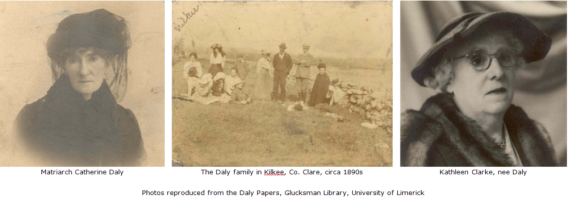
26 William Street
On the night of the census in 1901, the Daly family were resident in house number 26 in William Street. Among those present were the Fenian John Daly, his sister-in-law Catherine and her eleven children. Among the latter were Madge and Kathleen, who held strong republican views and were founder members of and dominant forces in Cumann na mBan in Limerick city. In addition, both women established businesses to employ local women and were active throughout the revolutionary period.
Daly Family Profile[1]
The history of Cumann na mBan in Limerick is inextricably intertwined with the history of the Daly family. They dominated the organisation in Limerick. Madge Daly was the President of the provisional committee of Cumann na mBan in the city. She was the driving force of the branch. Laura Daly was also a member of the committee. Madge served as President for almost all of the period from initiation in 1914 until disbandment in 1924. The only exception was a spell in 1921 when the newly widowed Kate O’Callaghan was unanimously elected President for the year. As well as Madge and Laura, their sisters Kathleen, Agnes, Caroline and Nora were all heavily involved. The activities of the branch centred around the Daly women and their home.
In fact, the Daly family as a whole, men and women, are a prime exemplar of family involvement in the republican movement. Edward Daly and his wife Catherine (née O’Mara) lived at 26 Frederick Street (now O’Curry Street). They had ten children, nine daughters and one son. Catherine ran a successful dressmaking business but had less success in running a public house after the death of her husband in 1891. Their son Edward was born after his father died. Edward Senior had taken part in the Fenian Rising of 1867 along with his brother John. John, a leading Fenian, assumed the role of father figure to the family on his release from twelve years of imprisonment in 1896. In the meantime, another brother, James, had paid for Kathleen to complete a dressmaking apprenticeship. She ran her own business in Cecil Street, and later took larger rooms O’Connell Street. Edward Junior joined the Fianna, the IRB and the Volunteers as soon as he was of age. He was executed for his part in the 1916 Rising, as was his brother-in-law Tom Clarke, husband of Kathleen. Kathleen was later elcted to the Dáil and served as Mayor of Dublin. Nora Daly married Volunteer Éamonn Dore. Laura’s husband, Volunteer Séamus O’Sullivan, lived in the attic over John Daly’s home at 15 Barrington Street for a year after their marriage in May 1918. John opened a bakery at 26 William Street, which Madge took over after he was incapacitated. Madge had previously worked in the millinery department at Cannocks. Cumann na mBan often met in the Fianna Hall in Barrington Street or in the bakery.
Most of the Limerick members of Cumann na mBan came from families who were steeped in republican tradition and many were related to Volunteers, members of Sinn Féin or other members of Cumann na mBan. There was a social side to the organisation, and the circumstances of political unrest probably facilitated more open interaction between young men and women than would otherwise have been the case. Many Cumann na mBan members and Volunteers around the country married one another. Following the national pattern, many of the women were related to Volunteers and indeed met their husbands through their nationalist activities.
While the Volunteers were rendered almost completely impotent by the surrender of their weapons and the imposition of what was tantamount to martial law after the Rising, the police were aware of more or less immediate efforts on the part of the ‘Sinn Féin revolutionary movement’ in Limerick to sustain and build subversive momentum at underground meetings and through the Irish National Aid League and Irish Volunteers Dependents’ Fund. Cumann na mBan, led by the Daly sisters, administered the Volunteers Dependents’ Fund in Limerick from June 1916. Not only did Cumann na mBan fundraise, hold commemorations, work for prisoner welfare, contribute to the propaganda machine, and participate in the election and anti-conscription campaigns, but they provided a cover behind which rebels who escaped arrest could begin to rebuild the Volunteers. Madge Daly gave jobs in the family bakery business to two Dublinmen, Peadar Dunne and Peadar McMahon, on their release from Frongoch in December 1916. The police followed the activities of Madge Daly very closely because she provided her premises to the Volunteers for training exercises.
Madge often dictated to, rather than simply followed the lead of, her male colleagues. She had a direct and controlling influence, for instance, on one of the major developments in the republican campaign in Limerick, namely a split within the ranks of the City Volunteers from 1917 until 1921. She did all in her power to discredit the officers who had been in charge at Easter 1916 as incompetent and she was highly effective in this effort.
On 2 May 1918 Lord Dunraven, who advocated conscription, was struck off the Roll of Freemen of Limerick. De Valera, MacNeill and Kathleen Clarke, as representatives of the proscribed Sinn Féin, Gaelic League and Cumann na mBan organisations, were added to the roll in November.
In the summer of 1921, on the morning of the execution of Volunteer Thomas Keane, Laura Daly, carrying a banner she had borrowed from Fr Hennessy of the Augustinian Church, led Cumann na mBan in a procession to the walls of the New Barracks on Lord Edward Street (now Sarsfield Barracks). Several of them were badly beaten by members of the Crown forces.
During the Civil War, the very last group of anti-Treatyite republicans to leave the New Barracks on Lord Edward Street (now Sarsfield Barracks) were the women of Cumann na mBan led by Madge Daly. This was on 22 July 1922, when fire took hold and every building became a blazing inferno following shelling by pro-Treaty Free State forces.
[1] The information in this profile is taken from John O’Callaghan, Revolutionary Limerick: The Republican Campaign for Independence in Limerick, 1913-21 (Dublin, 2010); John O’Callaghan, The Battle for Kilmallock (Cork, 2011); Deirdre McCarthy, ‘Cumann na mBan – The Limerick Link’ (unpublished M.A. thesis, University of Limerick, 1992).
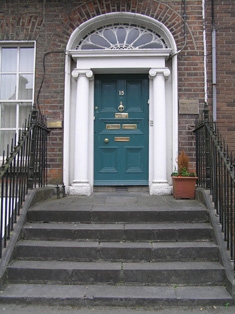
The Dalys’ home at 15 Barrington Street became the centre for republican activities before and after the 1916 Rising. During Easter Week, as orders about the course of the Rising changed, representatives of the Irish Volunteers and Cumann na mBan called to Madge Daly to request contact with local activists. Madge, Laura and Agnes acted as intermediaries, carrying messages from Pearse to local Volunteers in the city and county. Madge Daly was bitterly disappointed at the lack of action in Limerick city and, along with Laura, travelled to Dublin.
The Daly women paid a price for their revolutionary activity: their brother Ned died, Kathleen became a widow with three young children, and many of the visitors to their house died. The Daly home was raided and searched by the RIC on 11 May 1916; during the War of Independence, an RIC inspector described the house as a ‘veritable wasp’s nest of Sinn Fein.’ (McCarthy, 1992, p. 134).
The Dalys moved to Ardeevin, Ennis Road, Limerick in August 1919.

Professor Kathleen (Kate) O'Callaghan (née Murphy; 1888 – 16 March 1961), sister of fellow Cumann na mBan members and lecturers in Mary Immaculate College of Education Eilís Ní Mhurchú and Máire O’Donovan, was an academic and politician. She was educated at the Royal University of Ireland and Cambridge. She was the widow of Michael O'Callaghan, Mayor of Limerick and an IRA officer, who was killed in their home (St. Margaret’s on what is now O’Callaghan Strand) and in her presence by British forces in March 1921. She was first elected to Dáil Éireann as a Sinn Féin representative at the 1921 elections for the Limerick City–Limerick East constituency. She voted against the Anglo-Irish Treaty and was re-elected at the 1922 general election. In accordance with Sinn Féin abstentionist policy of the time, she did not take her seat. Along with her sisters Máire and Eilís and brother Matt, she took the anti-Treaty side in the Civil War. All but Máire were jailed during this period. Kate lost her seat at the 1923 general election.
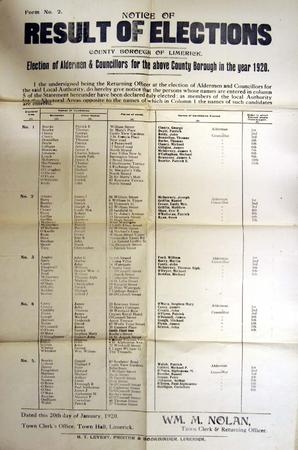
Pictured above election results for Mrs. Emily Crowe of 25 Sarsfield Street.
The Local Government (Ireland) Act 1919 introduced proportional representation into the local electoral system. All councillors were to be elected by single transferable vote from multi-member electoral areas. All aldermen and councillors were to go out of office simultaneously at the time of a local election. Proportional representation was used for the first time in the municipal election held on 15 January 1920 during the Irish War of Independence. A Sinn Féin majority of twenty-six councillors was elected, including the first-ever woman to sit on Limerick Corporation, Mrs. Emily Crowe of 25 Sarsfield Street.
Emily Crowe represented the Custom House and Market Wards. A second woman, Máire O’Donovan, also a member of Cumann na mBan, was co-opted as a councillor on 7 April 1921 to replace the late Sinn Féin Mayor, George Clancy, who had been assassinated by Crown forces. That same day, Robert de Courcy was elected to take the place of Councillor Michael O’Callaghan, who had been assassinated on the same night as Clancy. O’Donovan became the first woman to act as Mayor of Limerick, when she deputised for Mayor Stephen O’Mara from May 1921 until January 1922.
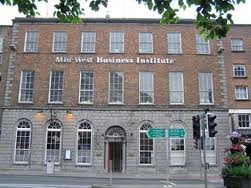
The Local Government (Ireland) Act 1919 introduced proportional representation into the local electoral system. All councillors were to be elected by single transferable vote from multi-member electoral areas. All aldermen and councillors were to go out of office simultaneously at the time of a local election. Proportional representation was used for the first time in the municipal election held on 15 January 1920 during the Irish War of Independence. A Sinn Féin majority of twenty-six councillors was elected, including the first-ever woman to sit on Limerick Corporation, Mrs. Emily Crowe of 25 Sarsfield Street. She represented the Custom House and Market Wards. The Corporation met in City Hall, Rutland Street.
A second woman, Máire O’Donovan, also a member of Cumann na mBan, was co-opted as a councillor on 7 April 1921 to replace the late Sinn Féin Mayor George Clancy, who had been assassinated by Crown forces. That same day, Robert de Courcy was elected to take the place of Councillor Michael O’Callaghan, who had been assassinated on the same night as Clancy. O’Donovan became the first woman to act as Mayor of Limerick, when she deputised for de Courcy later that year (Limerick Leader, 19 January 1920, 23 January 1961).
O’Donovan was born in Crossmahon, near Macroom, in county Cork in 1876. She was the daughter of Julia and Cornelius Murphy. Her sisters Eilís and Kate were also university graduates and lecturers in Mary Immaculate College of Education.
On 21 May 1921, Mayor Stephen O’Mara appointed Alderman O’Donovan as his deputy during his absence and she became Limerick’s first female mayor, remaining in office until 30 January 1922. She presided over the ceremony in which Éamon De Valera and Kathleen Clarke received the Freedom of the City in December 1921. Along with her sisters Kate and Eilís and her brother Matt, O’Donovan took the anti-Treaty side in the Civil War.
Máire O'Donovan died in Limerick on 20 January 1961.
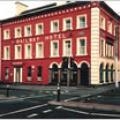
Cumann na mBan member Mrs Bermingham’s pub and home at the junction of Davis Street and Parnell Street, at the opposite side of the junction to McEnery’s Railway Hotel and across the road from the railway station, was bombed and burnt by Crown forces in reprisal for Irish Republican Army actions in Limerick on 15 August 1920. The premises, at 34 Davis Street, is now the site of an off-licence establishment.
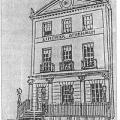
On Sunday 5 January, Cumann na mBan held a ‘Prisoners' Day’ in the Theatre Royal, Henry Street. Cumann na mBan organised and presided over the meeting rather than adopting an auxiliary role. Hanna Sheehy Skeffington spoke, having been invited by Kate O’Callaghan. Máire O’Donovan chaired proceedings. Madge and Agnes Daly were also on the platfor
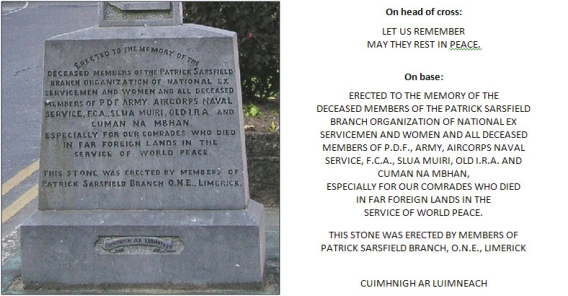
This memorial, standing in the centre of the road in Pery Square, Limerick City, is a Celtic cross on an oblong base. The inscription is on the base. The head of the cross has the badges of the Defence Forces, the Naval Service, the Air Corps and Óglaigh Náisúinta na hÉireann Teoranta (Organisation of National Ex-Servicemen and Women). On the shaft of the cross are reliefs of Patrick Sarsfield and the Treaty Stone. The memorial is approximately 2.5 metres in height and 1 metre wide at the base, with a depth of half a metre.
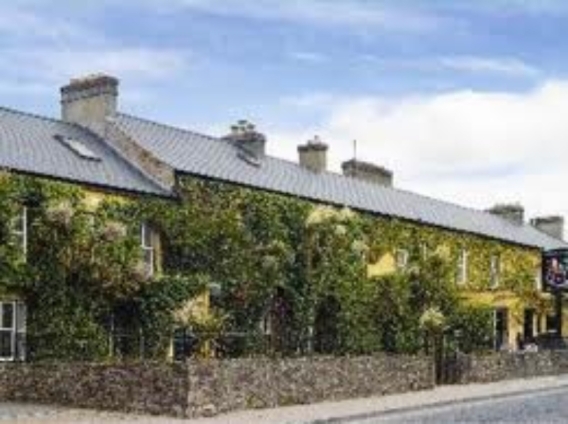
During the Civil War, there was heavy fighting in the town of Adare in county Limerick on 4/5 August 1922. Anti-Treaty Irish Republican Army forces occupying the town came under artillery fire from pro-Treaty Free State troops. The Dunraven Arms Hotel, where the Republicans had set up their headquarters, was hit by a number of shells. The publicity department of the Free State South Western Command announced that when their troops entered the hotel, ‘all the rooms in the building were found to be bespattered with blood, showing that there must have been fairly severe casualties …’.
Mary Hartney, according to an Irish Republican Army list of Mid Limerick Brigade casualties, was ‘killed in Adare while attending our troops.’ She was hit by shellfire while working in the first aid centre at the Dunraven Arms and was one of only a few members of Cumann na mBan killed in either the War of Independence or the Civil War. She was buried in Mount St Lawrence Cemetery on Monday 7 August. According to the Limerick Chronicle, ‘the cortege was of large and representative portions, and expressed the sympathy felt for the husband and family of the deceased’.
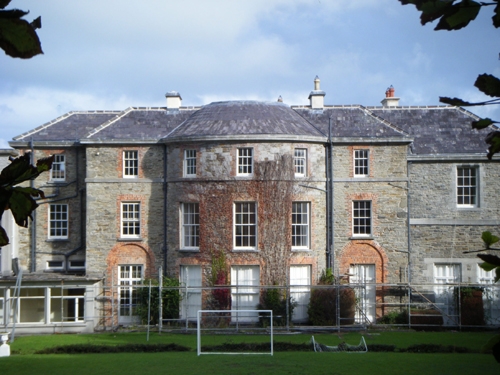
Mount Trenchard, Foynes
Mary Spring Rice came from Mount Trenchard demesne, Foynes. Her background, as an unmarried daughter of Ascendancy gentry, was somewhat unusual in the context of Cumann na mBan, where most of the members were middle class Catholics. Spring Rice was a member of the Glin branch of Cumann na mBan.
The Gaelic League occasionally held Irish language classes in Mount Trenchard.
Spring Rice was centrally involved in the organisation and operation of the Howth gun running in July 1914 with the Childers – Erskine and Molly, Sir Roger Casement and Alice Stopford Green. Together with Molly Childers, Mary Spring Rice raised £2,000 towards the purchase of the 900 Mauser rifles from Germany, many of which were used in the 1916 Rising.
Spring Rice sailed on the Asgard with the Childers. In September 1914 she lectured on first aid for the injured, hygiene and emergency nursing and ambulance work in the Volunteer Hall in Glin. She made Mount Trenchard available to the West Limerick Brigade of the Irish Republican Army during the War of Independence.
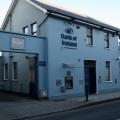
RIC Barracks, Kilmallock
On 28 May 1920 over 100 Volunteers of the Irish Republican Army attacked the RIC barracks in the town of Kilmallock in County Limerick. It was one of the largest military confrontations in the War of Independence. Volunteer James Maloney noted that a Cumann na mBan contingent ‘used a rifle and kept the kettles boiling as occasion demanded’. While members of Cumann na mBan provided safe houses, food and clothing for men on the run, frequently cared for wounded men, distributed propaganda, officiated in the republican justice system, raised funds, gathered intelligence and acquired arms, it was extremely rare for them to engage in combat operations.